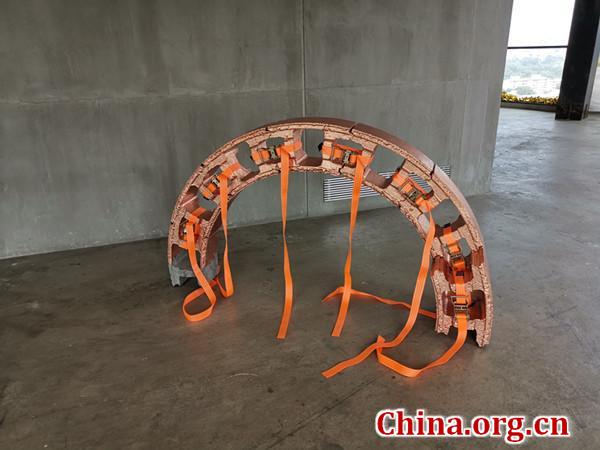Gold flow shines at contemporary art show
- By Jay Birbeck and Wu Jin
 0 Comment(s)
0 Comment(s) Print
Print E-mail China.org.cn, August 11, 2020
E-mail China.org.cn, August 11, 2020
Life resembles a pendulum relentlessly swinging between birth and death, gain and loss and acquaintance and farewell.

"Gold Flow," a collective art exhibition opened on Friday at the Hotel Sanlitun Chao Beijing, attempts to reveal the essence of life by seeing through its hallucinated prosperity, ostentatious modernity as well as growing trepidation amid the crisis of the COVID-19 pandemic.
According to Yang Zi, curator of the exhibition, the striking color of gold epitomizes China's rapid economic development over the past few decades, which, however, gives rise to metaphysical discussions on life and death and beliefs and myths.
The paintings and sculptures displayed in multifaceted dimensions are supposed to lead the viewer to sequestered contemplation against the background of the hustle and bustle of modern life centered on production, consumption, capital and finance.
The entire exhibition starts from a clock, however, with its numbers and needles replaced by human statues and a pair of chopsticks, respectively. On a blackboard, all are gilded in gold.
The clock indicates farewells and reincarnations that usher in the principal guideline of this exhibition, Yang introduced.
All works in the two-story exhibition center located at Floor 27 of the hotel are overlooking the skyline below, where the throbbing business and commercial hub of Sanlitun fits well with this artistic taste.
To make good use of the scenery, Wang Shang, a jewelry designer turned contemporary artist, put a stone-made key-shaped sculpture opposite a window. At both ends of the "key" are installed two mirrors reflecting the blaring busy streets outside.
According to Yang, by choosing geological resources to produce the sculpture reflecting the city beat of the human race's heart, the artist is providing an opportunity for people to retrospect on the reflection of the mirrors.
"They may understand that nature and its geological resources have existed since a remote age earlier than human history. Therefore, the combined elements in this sculpture create a feeling of tension and bewilderment," he explained.

Artist Zang Kunkun made an arch with eight hollowed and gilded bricks collected from a construction site to indicate people's uncertainties about the things they used to take for granted, many related to the consumption-driven society.
However, consumption-led greed is not a consequence of the contemporary age only. In late Chinese caricaturist Zhang Guangyu's serialized comic strips published in 1945 - a year marking the end of the Chinese People's War of Resistance against Japanese Aggression (1931-1945) and also the outbreak of the Civil War of 1945-1949, the artist satirized the government's incorrigible corruption and the ruling class' unbridled greed from the perspective of a protagonist "Bajie." The character was adopted from "Journey to the West," one of China's classic novels written in vernacular language.
Concerning the desire for worldly things, artist Li Weiyi arranged arrays of paper-cuttings resembling disparate accessories on a long green-carpeted table. Beside the table a gold colored traditional Chinese character "Meng" (dream) hangs from the ceiling. The bottom part of the character reflects the arrangement of the table, which, according to the curator, is grotesque in design.
"Basically, the artist is trying to say that the worldly mindset, such as, satisfying one's desire with lavish expenditure, is abstruse as well," Yang said.
Away from Li Weiyi's unique worldly dream, one can easily spot another dream which is much more sublime, but also contradictory in appearance - two posters with an excerpt from Martin Luther King Jr.'s "I have a dream" speech, hanging on top of the twin stairs.
Visitors may misjudge the posters as being translated into Russian at the first sight. However, on taking a closer look, they may find all of the words are actually written with English lexicon.
In addition to paying homage to history, this exhibition also demonstrates some artists' growing concerns towards the future world.
The imitative painting named "Three Graces" by artist Jiang Cheng has aroused vigilance against wars and their devastating ramifications. The allusion she adopted from the world's masterpiece under the same name actually refers to the Trojan War, which according to "Homer's Epic," was triggered by "the Golden Apple of Discord" among three goddesses—Hera, Athena and Aphrodite.

While some artists question whether cycles of history repeat, the others hold critical views towards common values.
Artist Gao Weigang who made a hollowed chair with its rims being painted with pure gold illustrated that lots of splendid and treasurable things worshipped in this world may actually not be so valuable as they have been promoted.
The exhibition will run until September 6.
Opening hours:
1:00pm-9:00pm, from Monday to Thursday
1:00pm-10:00pm, on Friday and Sunday
Address:
Floor 27, Sanlitun Chao Beijing, No. 4 East Road of Beijing Workers' Stadium, Chaoyang District, Beijing






Go to Forum >>0 Comment(s)